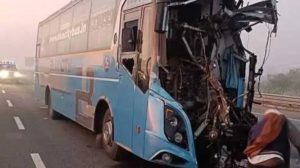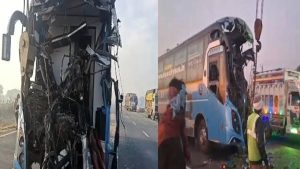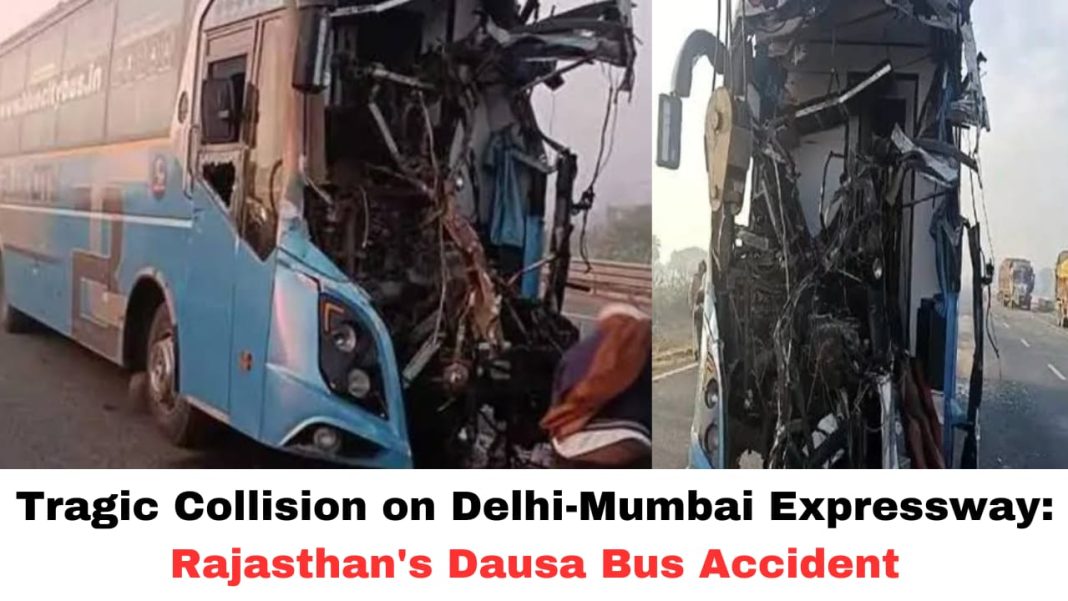Digital News Guru Rajasthan Desk:
In a heart-wrenching incident, a major road accident took place on January 2, 2025, on the Delhi-Mumbai Expressway near Lahdi Ka Bas village in Rajasthan’s Dausa district. The accident involved a private bus carrying devotees and two trucks that had collided earlier. This tragic event resulted in 45 injuries, leaving many critically hurt and raising concerns about the safety of travel during dense fog conditions that are prevalent in northern India during winter.
Rajasthan’s Dausa Bus Accident: The Incident
The accident occurred in the early hours of the morning, a time when dense fog significantly reduces visibility on highways. The private bus, en route from Ujjain to Delhi, collided with two stationary trucks that had earlier met with an accident on the expressway. The lack of visibility compounded by high-speed travel proved fatal as the bus could not stop in time to avoid the stationary vehicles.

The impact was severe, leading to the front section of the bus being mangled. Eyewitnesses reported scenes of chaos as passengers scrambled to escape the wreckage, while others lay injured, awaiting assistance.
Casualties and Medical Response
A total of 45 individuals sustained injuries in the accident. Among these, over 20 passengers were immediately rushed to Dausa District Hospital for treatment. Due to the severity of their injuries, four critically injured passengers were referred to hospitals in Jaipur.
To manage the influx of patients, the authorities deployed additional medical staff at Dausa District Hospital. The rapid response of emergency services, including local police and medical teams, played a crucial role in minimizing fatalities. However, the long-term recovery of the injured remains uncertain.
Contributing Factors
This accident serves as a stark reminder of the dangers posed by foggy weather conditions during winter. The northern regions of India, including Rajasthan, frequently experience dense fog, which can severely limit visibility for drivers. On this particular occasion, the combination of poor visibility, high speed, and inadequate caution led to a tragic outcome.
Authorities often issue advisories urging drivers to reduce speed and use fog lights during such conditions. However, compliance with these guidelines remains inconsistent. Additionally, the two trucks involved in the initial accident were not adequately marked, leaving other road users unaware of the obstruction, which directly contributed to the secondary collision involving the bus.

Impact on Passengers
The passengers on the bus were primarily devotees returning to Delhi after visiting Ujjain, a city renowned for its religious significance. For many, this pilgrimage turned into a nightmare. Survivors recounted harrowing tales of the moments leading up to and following the collision. Families of the injured have expressed concerns over the lack of timely communication about their loved ones’ conditions.
The psychological toll on survivors cannot be understated. Witnessing such a traumatic event can lead to long-term emotional distress, especially for those who lost friends or family members in the crash.
Highway Safety Concerns
The Delhi-Mumbai Expressway, a vital infrastructure project, has significantly improved connectivity between major cities. However, incidents like this highlight the urgent need for enhanced safety measures on such high-speed corridors. While the expressway is equipped with advanced infrastructure, including surveillance cameras and emergency response systems, the effectiveness of these measures is often called into question during emergencies.
Authorities must address several critical safety gaps, including:
- Regular monitoring and swift clearance of accidents to prevent secondary collisions.
- Improved signage and markings to alert drivers of hazards.
- Increased awareness campaigns about safe driving practices during adverse weather conditions.
Lessons Learned
The Dausa bus accident is not an isolated incident. It reflects broader issues in road safety management across India. According to data from the Ministry of Road Transport and Highways, fog-related accidents account for a significant percentage of road fatalities during winter months. This calls for a multi-pronged approach to improve safety:
- Technological Solutions: Advanced warning systems that notify drivers of hazards ahead can reduce accidents.
- Strict Enforcement: Ensuring compliance with speed limits and traffic laws is crucial, especially during adverse conditions.
- Public Awareness: Educating drivers about the risks of fog and the importance of defensive driving can save lives.
Conclusion
The tragic bus accident in Dausa serves as a grim reminder of the vulnerability of road users in challenging weather conditions. While the immediate focus remains on providing medical care to the injured, the long-term solution lies in addressing systemic issues in highway safety.
Enhanced infrastructure, stricter enforcement of traffic regulations, and widespread public awareness can collectively reduce the occurrence of such devastating accidents. As we mourn the lives affected by this tragedy, it is imperative for authorities and citizens alike to take steps to prevent such incidents in the future.
You May Also Read: PM Modi Condemns Terrorist Attack in New Orleans: A Global Stand Against Terrorism









